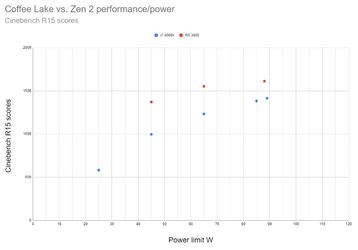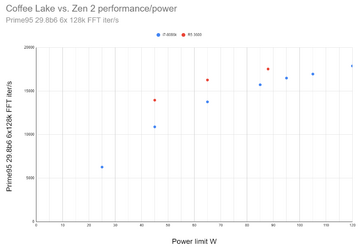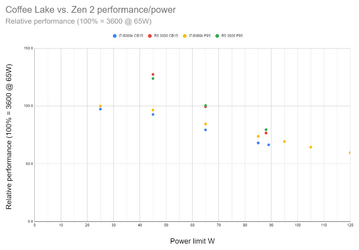- Joined
- Mar 7, 2008
On the Intel side, I have an 8086k on Asrock Z370-Pro4 with bios 4.20. Ram is dual channel 3200C16 2x8GB. To set the power of the CPU, I used XTU setting both short and long duration power limits to be whatever I wanted to test. Default is unlimited.
On the AMD side, I have a 3600 on Asrock B450 Gaming ITX/ac with bios 4.50. That has AGESA Combo-AM4 1.0.0.3ABB, not ABBA with the "boost fix" as not available yet. Ram is dual channel 3200C16 2x16GB. To set the power of the CPU, I used Ryzen Master set to "auto-overclock mode", then deselected everything I could except the section containing PPT. PPT was varied to the power level I wanted to test. Default value is 88W. Other limit values were also increased by default in this mode, but since they weren't limiting at stock, it shouldn't be significant.
It should be mentioned the testing below is only valid in the case that Intel PL1/PL2 levels and AMD PPT are effectively doing the same thing, regulating the power taken by the CPU/socket. If you know of any reason this is NOT the case, please elaborate.
For loads I tested two, Cinebench R15, and Prime95 29.8b6. Cinebench isn't really sensitive to ram speed, and the settings used for Prime95 are not either, as they run within CPU cache.
I tested each with different power limits set to the CPU. On the 8086k, I tested at points from 25W, to highest of 120W which can be drawn by Prime95. On the 3600 it was much more limited in scope. Lowest I tested was 45W, as I found the lowest that can be set was 44W. Increasing the power limit from default didn't prove too useful. Cinebench R15 was topping out about the default value of 88W. Prime95 was able to draw more than 88W, but at that point the CPU was getting too hot and the clocks could be seen dropping within seconds of applying load. This isn't a hard thermal throttle, but it is certainly in a soft throttle zone around 85C, compared to indicated limit in Ryzen Master of 95C. Performance should be better with better cooling than the Noctua D9L I used, but if you have the stock cooler expect much worse performance.

Starting with the Cinebench R15 results, it is clear the 3600 is much higher performing than the 8086k at any given power level. Even with unlimited power set, the Intel CPU only took 89W with this load.

With Prime95 the story is similar, with the 3600 providing more throughput at a given power level. However this time the 8086k scales up further with power. If you don't mind pushing more power through it, it just manages to overtake the 3600.
So, we have scores, we know the power used to get those scores. Divide the latter into the former, we have a performance per watt measure. To make the tasks more comparable, I've normalised it such that the 3600 @ 65W is the 100% reference.

I should clarify, this is relative performance per watt. The red and green dot are actually on top of each other, both being 100% and 65W, but I slightly shifted them so they can be seen. While there are some small differences, the two workloads scale similarly on each CPU, but the 3600 is clearly proving more efficient within the tested range. Thermal limits prevented me pushing the CPU to higher powers, but if the trend continues it may get worse than Coffee Lake at that point. Extrapolating the other direction, there is potential for great performance per watt at lower powers. It could be really interesting to see Zen 2 mobile CPUs, although in that area Intel do have their latest 10nm CPUs which I don't have to test.
Random comments:
On the AMD side, I have a 3600 on Asrock B450 Gaming ITX/ac with bios 4.50. That has AGESA Combo-AM4 1.0.0.3ABB, not ABBA with the "boost fix" as not available yet. Ram is dual channel 3200C16 2x16GB. To set the power of the CPU, I used Ryzen Master set to "auto-overclock mode", then deselected everything I could except the section containing PPT. PPT was varied to the power level I wanted to test. Default value is 88W. Other limit values were also increased by default in this mode, but since they weren't limiting at stock, it shouldn't be significant.
It should be mentioned the testing below is only valid in the case that Intel PL1/PL2 levels and AMD PPT are effectively doing the same thing, regulating the power taken by the CPU/socket. If you know of any reason this is NOT the case, please elaborate.
For loads I tested two, Cinebench R15, and Prime95 29.8b6. Cinebench isn't really sensitive to ram speed, and the settings used for Prime95 are not either, as they run within CPU cache.
I tested each with different power limits set to the CPU. On the 8086k, I tested at points from 25W, to highest of 120W which can be drawn by Prime95. On the 3600 it was much more limited in scope. Lowest I tested was 45W, as I found the lowest that can be set was 44W. Increasing the power limit from default didn't prove too useful. Cinebench R15 was topping out about the default value of 88W. Prime95 was able to draw more than 88W, but at that point the CPU was getting too hot and the clocks could be seen dropping within seconds of applying load. This isn't a hard thermal throttle, but it is certainly in a soft throttle zone around 85C, compared to indicated limit in Ryzen Master of 95C. Performance should be better with better cooling than the Noctua D9L I used, but if you have the stock cooler expect much worse performance.

Starting with the Cinebench R15 results, it is clear the 3600 is much higher performing than the 8086k at any given power level. Even with unlimited power set, the Intel CPU only took 89W with this load.

With Prime95 the story is similar, with the 3600 providing more throughput at a given power level. However this time the 8086k scales up further with power. If you don't mind pushing more power through it, it just manages to overtake the 3600.
So, we have scores, we know the power used to get those scores. Divide the latter into the former, we have a performance per watt measure. To make the tasks more comparable, I've normalised it such that the 3600 @ 65W is the 100% reference.

I should clarify, this is relative performance per watt. The red and green dot are actually on top of each other, both being 100% and 65W, but I slightly shifted them so they can be seen. While there are some small differences, the two workloads scale similarly on each CPU, but the 3600 is clearly proving more efficient within the tested range. Thermal limits prevented me pushing the CPU to higher powers, but if the trend continues it may get worse than Coffee Lake at that point. Extrapolating the other direction, there is potential for great performance per watt at lower powers. It could be really interesting to see Zen 2 mobile CPUs, although in that area Intel do have their latest 10nm CPUs which I don't have to test.
Random comments:
- Certain people like to shout that Intel CPUs can draw above their rated TDP. Well, so do AMD CPUs. The 3600 is a 65W TDP part, and at stock running either Cinebench R15 or Prime95 it was on the 88W PPT limit.
- Even if Zen 2 is more power efficient, they still run hot. Power density has been speculated as a reason for this. The heat doesn't have the room to spread.
- It should be obvious, but even assuming the CPU reported powers are perfectly correct, it doesn't account for power usage anywhere else in the system. That could have a large diluting factor.
- I also observed how clock varied on both CPUs during this testing. This is too complicated to be included while I retain my sanity.
Last edited: